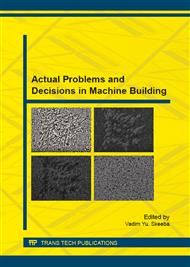[1]
N. V. Stepanova, A. A. Razumakov, E. A. Lozhkina, I. Y. Zhil'Tsov, V. A. Kuznetsov. Influence of Surfactants on the Structure and Wear Resistance of Copper Alloyed Hypereutectoid Steel. Advanced Materials Research. 1040 (2014) 53-58.
DOI: 10.4028/www.scientific.net/amr.1040.53
Google Scholar
[2]
N. V. Stepanova, A. A. Razumakov, E. A. Lozhkina. Structure and mechanical properties of Cu-alloyed cast iron. Applied Mechanics and Materials. 682 (2014) 178-182.
DOI: 10.4028/www.scientific.net/amm.682.178
Google Scholar
[3]
N. V. Stepanova, E. A. Lozhkina, A. A. Razumakov. Effect of Copper on the Friction Properties of Gray Cast Iron. Applied Mechanics and Materials 698 (2015) 364-368.
DOI: 10.4028/www.scientific.net/amm.698.364
Google Scholar
[4]
A. P. Prevarsky Investigation of the system Fe–Cu–Al (rus. ). Proceedings of the Academy of Sciences of the USSR. Metals. 4 (1971) 220–222.
Google Scholar
[5]
T. Chairuangsri, D. V. Edmonds. The precipitation of copper in abnormal ferrite and pearlite in hyper-eutectoid steels, Acta mater. 48 (2000) 3931–3949.
DOI: 10.1016/s1359-6454(00)00176-2
Google Scholar
[6]
Luowei Cao, Sujun Wu, Bo Liu, On the Cu precipitation behavior in thermo-mechanically embrittlement processed low copper reactor pressure vessel model steel Materials and Design, 47 (2013) 551–556.
DOI: 10.1016/j.matdes.2012.12.055
Google Scholar
[7]
A. A . Losinskaya, E. A. Drobyaz, V. A. Bataev, N. V. Plotnikova, M. G. Golkovsky. Structure and properties of the surface layers of low-carbon steel, obtained by deposition of carbonaceous powder mixtures and subsequent hardening (rus. ), Obrabotka metallov. 4 (2013).
Google Scholar
[8]
I. A. Bataev, A. A. Bataev, M. G. Golkovski, D. S. Krivizhenko, A. A. Losinskaya, O. G. Lenivtseva. Structure of surface layers produced by non-vacuum electron beam boriding. Applied Surface Science. 284 (2013) 472–481.
DOI: 10.1016/j.apsusc.2013.07.121
Google Scholar
[9]
B. Uhrenius. Hardenability Concepts with Applications to Steels (edited by D. V. Doane and J. S. Kirkaldy). ASM. Warrendale. Pa. (1976) 28.
Google Scholar
[10]
A. Yu Yakovlev, I. P. Volchok. The influence of copper on the properties of the graphitized steel (rus. ). Metallovedenie i termicheskaja obrabotka metallov. 1 (2008) 44-46.
Google Scholar


